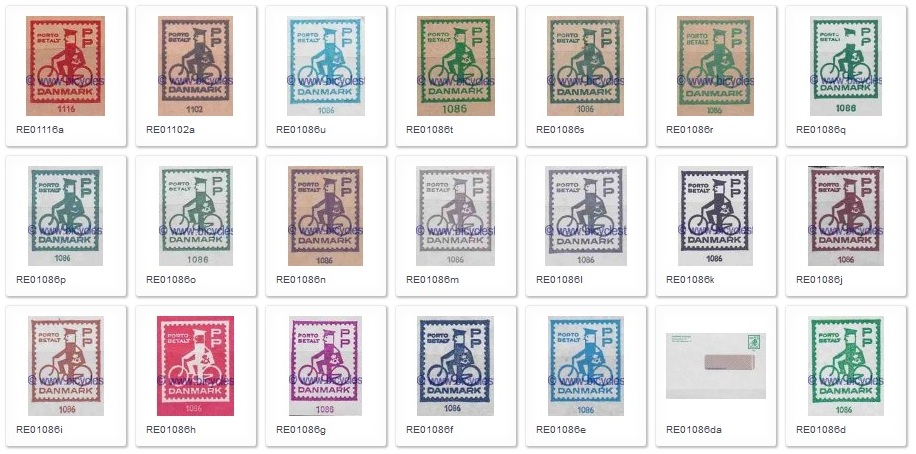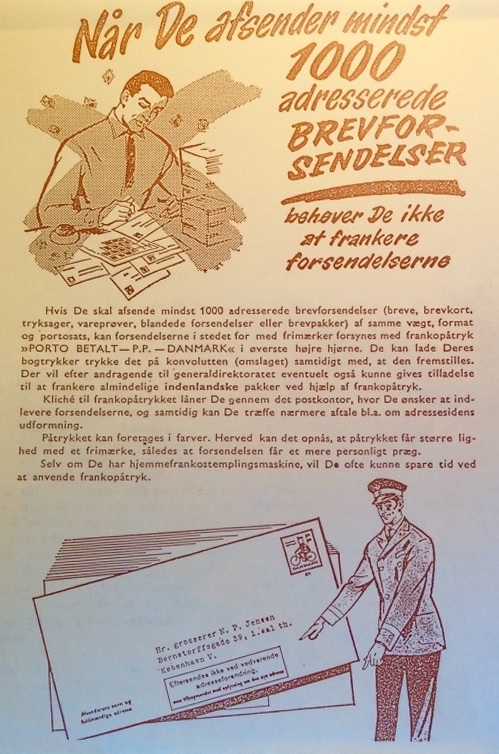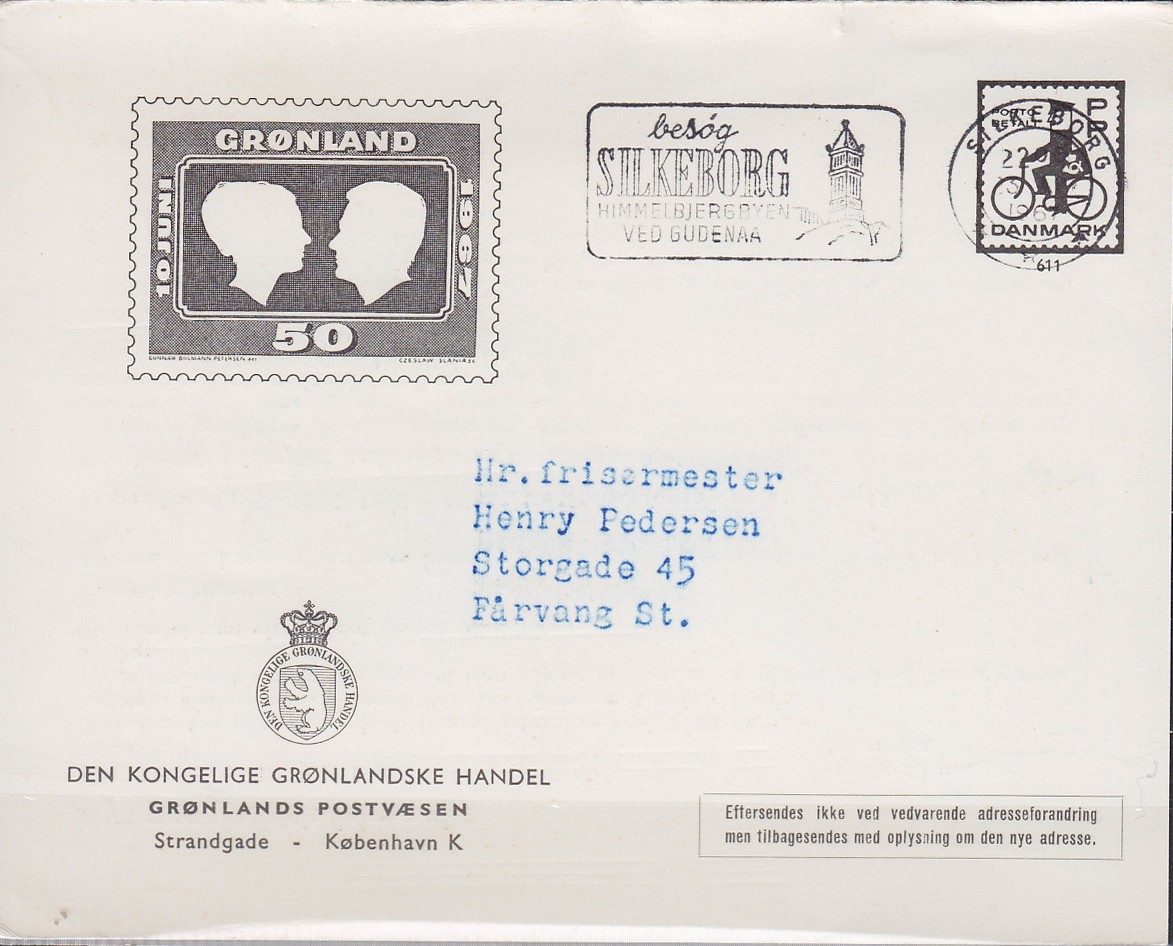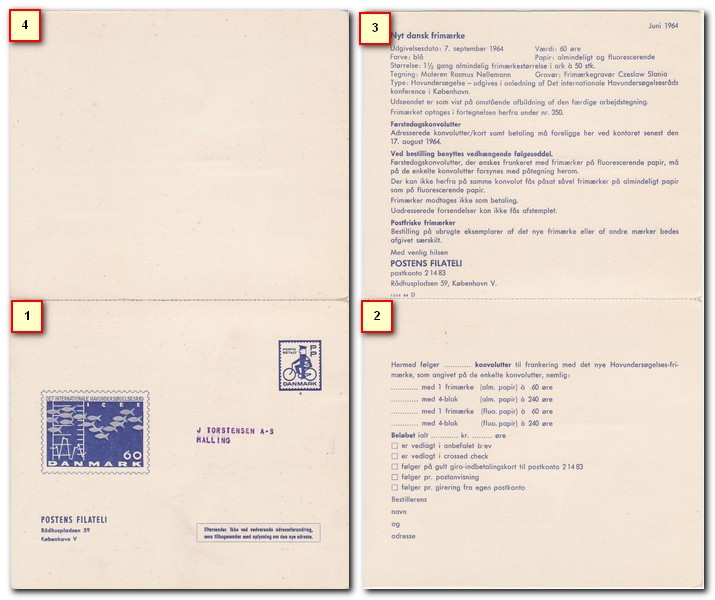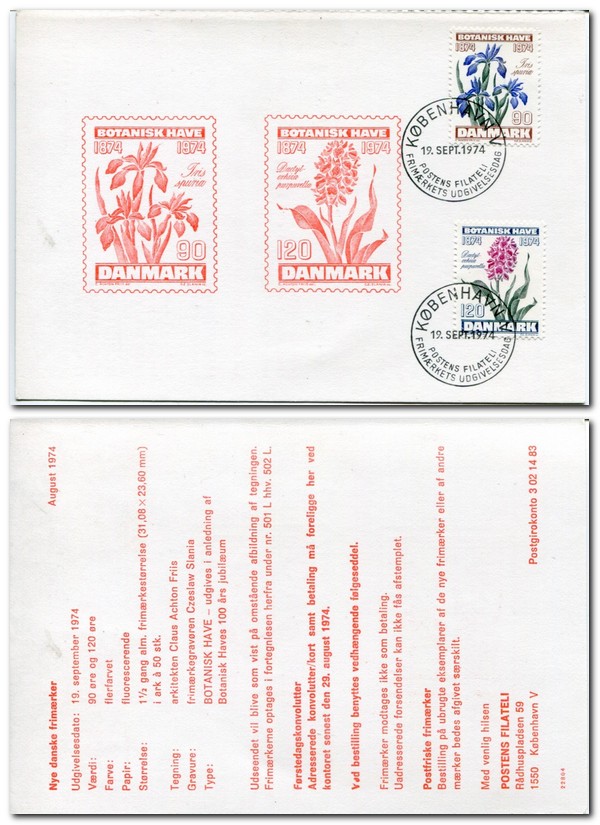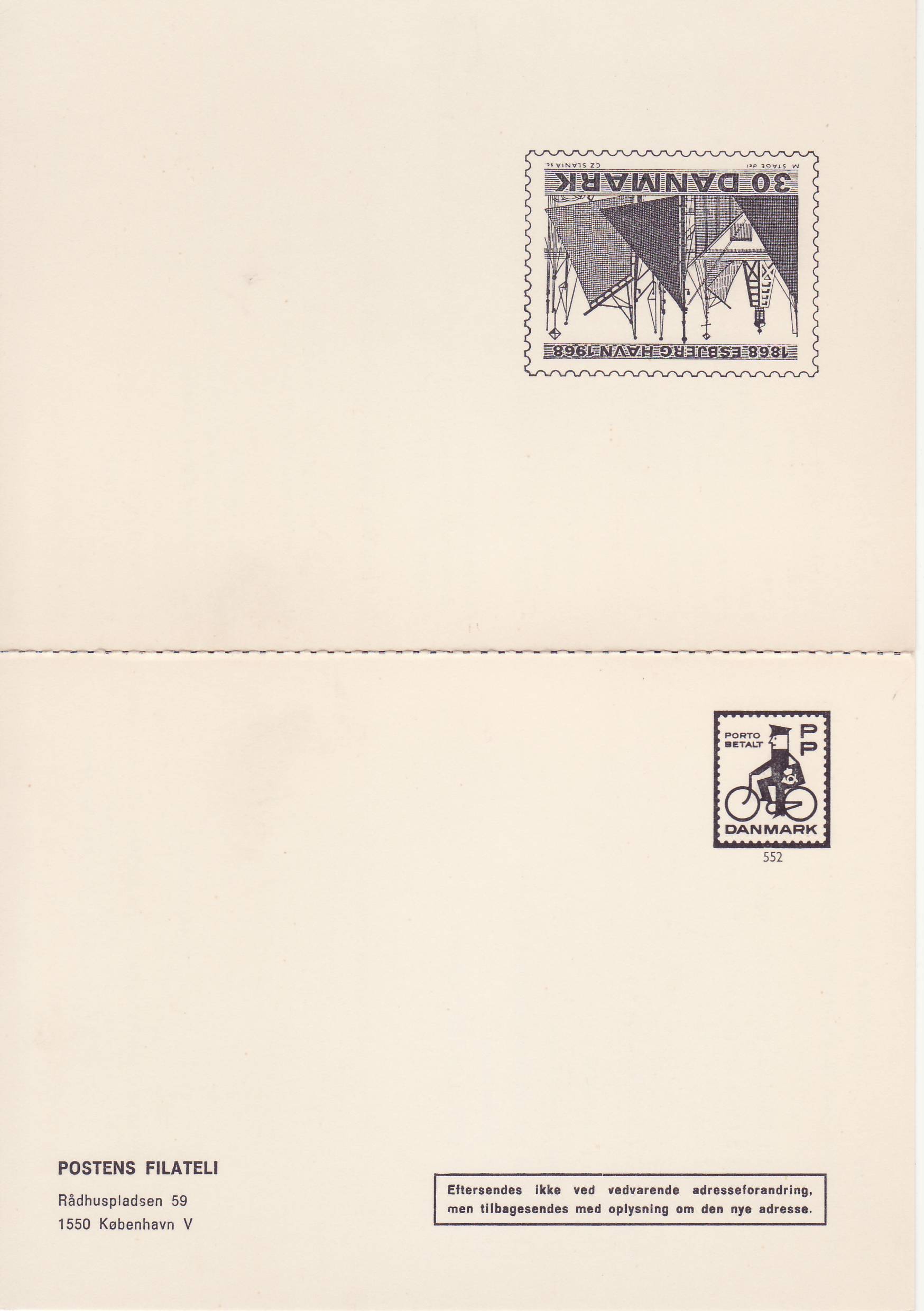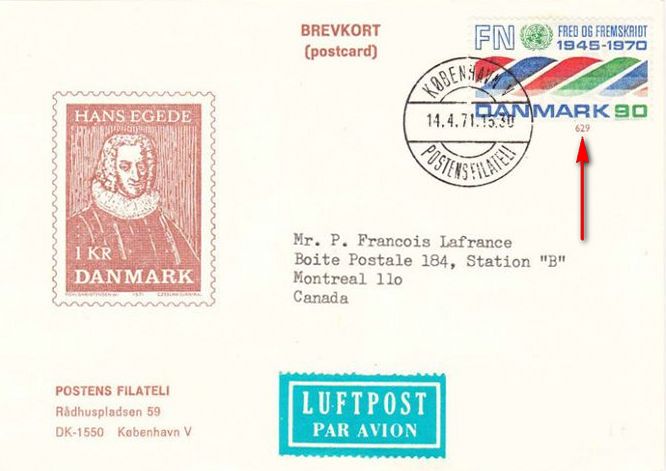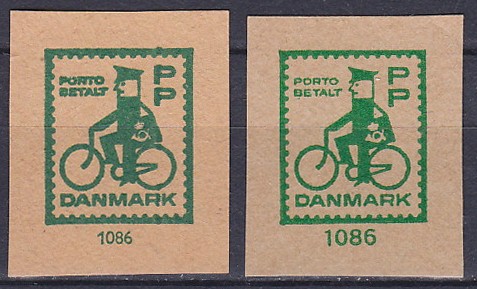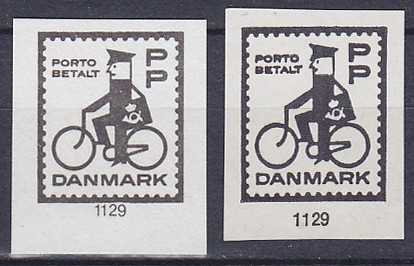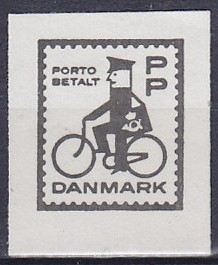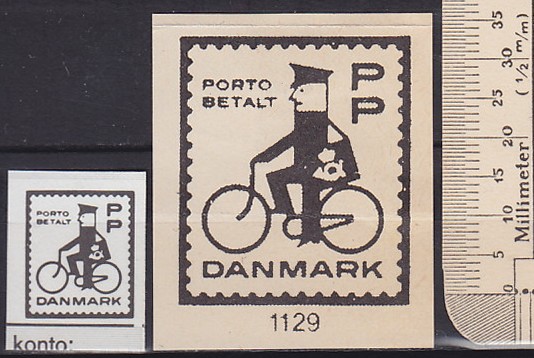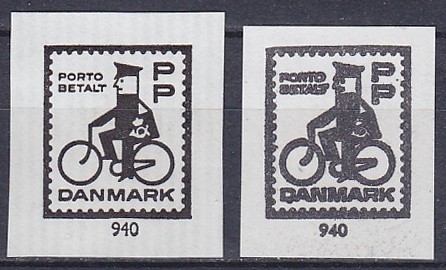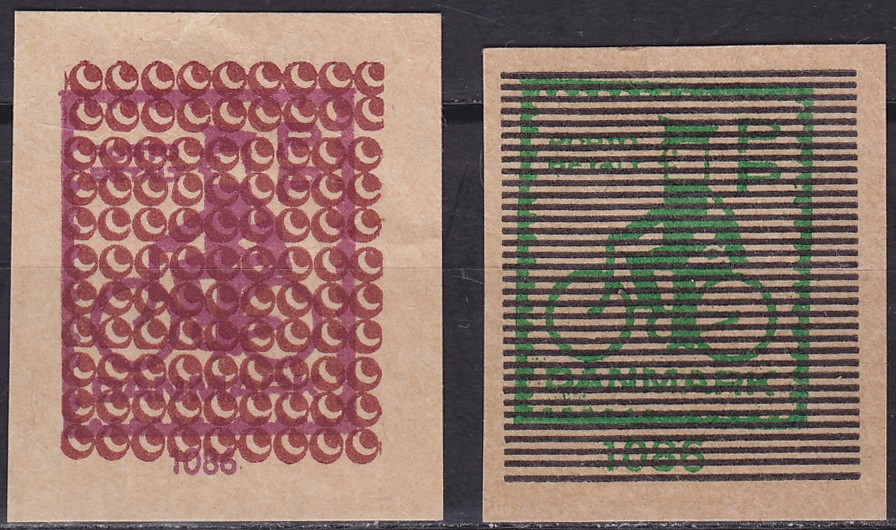Danish Postman “Porto Betalt” - P.P. postage paid
This postman (cyklende postbud) - designed by Carl-Henning Dalsgaard - started working on the 23rd October 1963 for the Danish Post and did this job for 24 years (--> 1986). He was responsible for the delivery of mass mailings such as postcards (Brevkort), printed matter (Tryksag), letters (Brev), .....
His work is documented by thousands of these objects - listed in the online catalog in chapter "stationeries, Denmark PP":
The album with the cut-outs gives a little impression of the variety of issues. It is far away to be complete.
The framed picture of the postman on his bicycle with the inscription PORTO BETALT = Postage Paid (PP) has not been changed over the years. The bulk mailings could only had been placed at certain post offices. In case of a customer order, the clichés with the cycling postman were sent to the printing house carrying out the order. The clichés were etched 4 mm deep, suitable for the printing of large orders. Later printing was done in the offset process.
The numbers served to manage the orders. The numbers 1 to 2400 have probably been assigned completely over the years. However, there are always gaps in lists and in the online catalog - for example are pictures with the following numbers in the range up to 1000 still missing:
108 127 130 131 170 177 178 179
205 209 221 225 252 269 273 291 297
306 313 314 329 335 339 344
452 457 476 477
502 505 506 534 537 558 583 592 599
617 618 623 624 631 637 644 645 677 678 693
701 702 703 704 705 706 708 710 722 728 732 742 747 753 756 780 787 791
816 819 820 831 832 841 851 854 855 856 857 864 865 866 867 868 874 881
906 913 937 938 944 946 960 965 966 971 974 983 986 992 994
Please have a look in your collection, maybe you can contribute to the completion of the online catalog. Just send an email to This email address is being protected from spambots. You need JavaScript enabled to view it..
The number range between 5000 and 5900 is also represented by a large number of cut-outs. The highest number is 7110. Same numbers can be found on different postal cards or envelopes. No. 1086 leads the hit list with 289 different known postal cards. It is only topped by cards without any number (333 different ones). On the other hand a certain postal card can have different numbers. The Danish Post (Postens Filateli) itself used these numbers in the years 1964 to 1975 for their own mail in 19 different numbers. Many other customers are known with 8 - 14 different ones.
The payment for the order had to be made at the post office counter (in cash?) when the cards/envelopes were handed in. The minimum order quantity was 1000 identical pieces. As the cyklende postbud slowly approached retirement (1985/1986), an order quantity of 300 was sufficient.
It is difficult to assign the number to a specific post office, as collectors generally only collected the cut-out "Postman with number" and not the complete postal stationery. So the senders name and address were lost, when the snippet was cut out. However, there exists a comprehensive Excel list - containing number, name (of the sender), zip code and postal district. The column with the date is nearly empty, because these bulk mailings were normally not stamped. With over 10 000 entries the Excel-table is so extensive, that it was probably not compiled by a single collector, but rather by a working group:
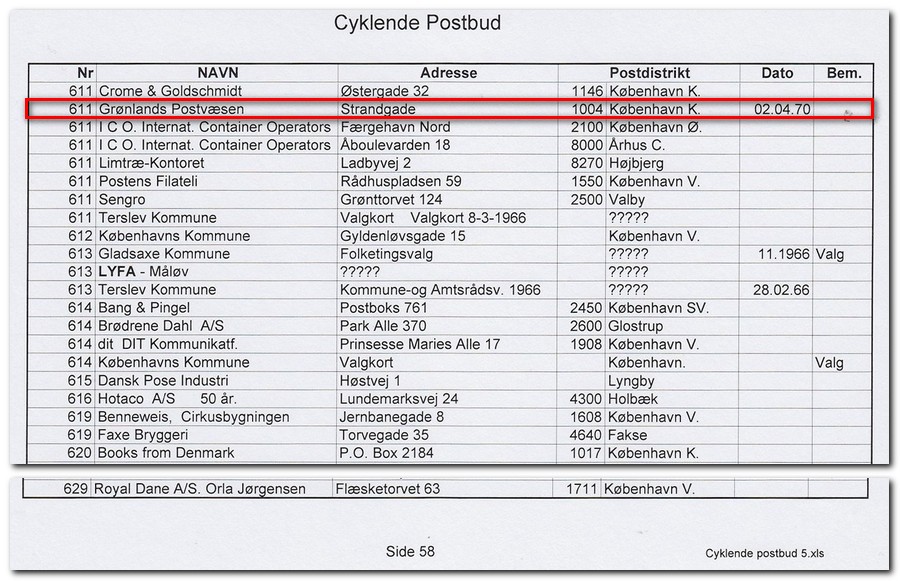 In this small excerpt the numbers 617 and 618 are missing – as mentioned further above. The senders of the eight entries with the number 611 come from the cities/urban districts of Copenhagen/Valby and Århus /Højbjerg. So apparently two post offices (approx. 200 km away from each other) used this number. The marked Greenland Post entry can be assigned to this postal stationery:
In this small excerpt the numbers 617 and 618 are missing – as mentioned further above. The senders of the eight entries with the number 611 come from the cities/urban districts of Copenhagen/Valby and Århus /Højbjerg. So apparently two post offices (approx. 200 km away from each other) used this number. The marked Greenland Post entry can be assigned to this postal stationery:
Shortly before reaching its destination in Farvang, the card was given an irregular postmark in Sikeborg - dated ...1967. This date corresponds with the first-issue-date of the stamp shown on the card: 10.06.1967. In the Excel table an other date is noted: 02.04.1970. This could refer to the stamp "The 25th Anniversary of the Liberation of Denmark" issued on May 4th:
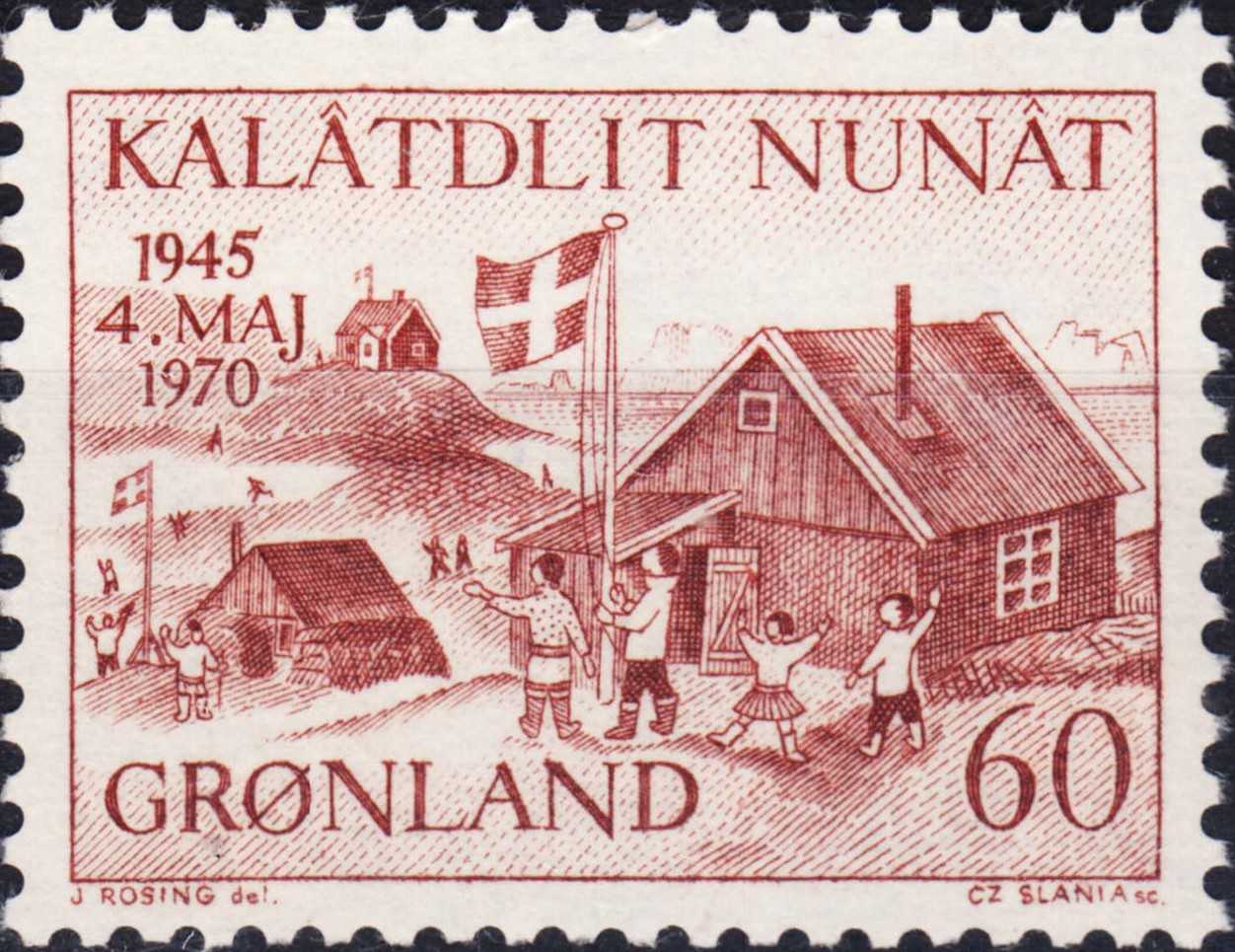
Further down in this article, a third card with the number 211 (issue date 18.09.1969) is presented. That means that at least 3 different cards exist for the single Excel entry “211 Grønlands postvæsen”.
In addition, these are the snippets shown in the online catalog for no. 611:

An assignment to the Excel data is unfortunately not possible. The origin/creator of the Excel file is not known. Perhaps you know more? If so - please let me know.
The postcards used by the Danish Post served mostly for advertising new stamp issues. They were initially designed as rouletted folding cards, whereby the back of the address side [1] became the order form [2]:
The text describing the new issue is shown on side [3]. This second part should had remained with the customer. But in fact many buyers sent back the card undivided. In this case Postens Filateli returned the 'customer part' of the card with an affixed stamp cancelled on the first day of issue on side [4]:
(address part [1] see here)
In this way the customer had a FDC including a description of the new issue. Other FDCs combine the address part [1] with the description part [3]. For us bicycle stamp collectors this of course is the more interesting variant: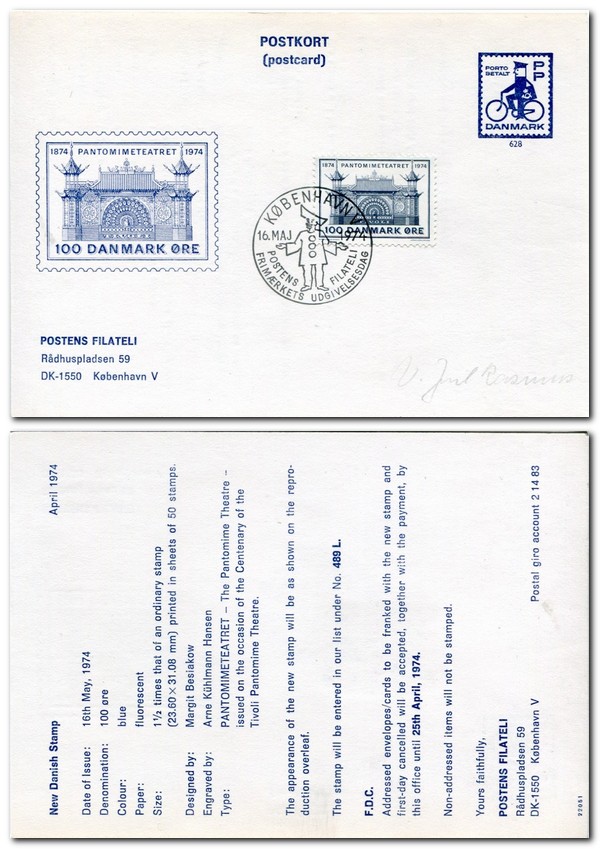
This FDC, sent from Greenland to Odense in Denmark, has a special “cancellation” on the address side [1]: 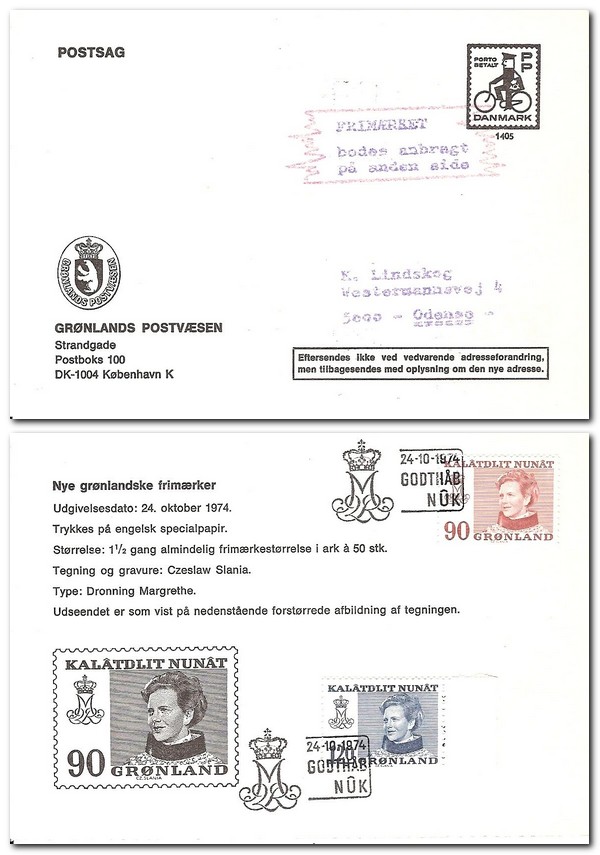
“Frimærket/bedes anbragt på anden side” (The attached stamp is to be found on the other side). It seems as if the Porto-Betalt-postman is not responsible for the postage. Even registered FDCs could be found: 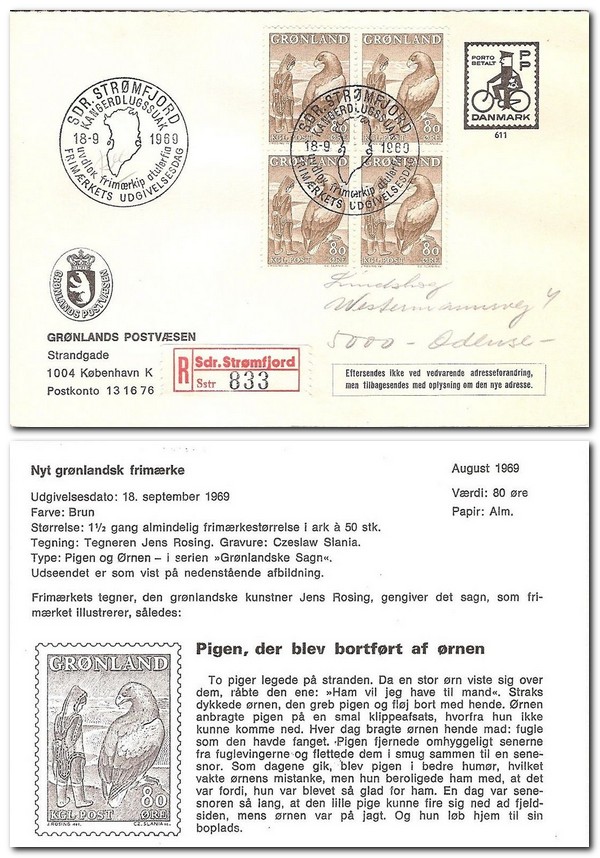
Question to the specialists: is this the correct postage? Nowadays these FDCs and complete folding cards are hard to find.
Only early postcards from the years 1964/1965 do not have the imprint “brevkort” on the address side. Another phenomenon: There also exist cards without an address, which have found their way into the collectors community:
Perhaps it was a supplement to another, anyway necessary mailing?
Postcards sent by AIR MAIL to foreign countries had an additionally affixed stamp hiding the cycling postman:
(address part showing the postman see here)
These ‘foreign cards’ had no attached customer part.
The quality control was not too strict in these (private printer) products, so that many print variants can be found, for example:
- - - different fonts for the numbers:
- - - the words "PORTO BETALT" unprofessionally repaired? 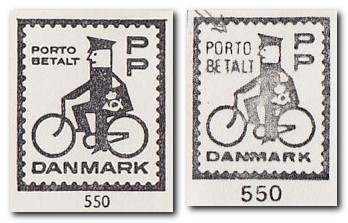
- - - different "perforation" 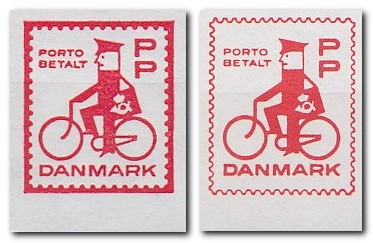
- - - different distance between number and frame
- - - frames of different size
- - - printing with a paint surplus makes the "perforation" appear quite different:
- - - overprints for example no. 1086:
- - - printing on different-colored paper or paper with a different structure also makes the stamp appear in a different color.
With this motif, which has remained unchanged for over 24 years, the cyklende postbud probably surpasses all of the European kingdoms' permanent issues/definitives. He holds another world record with the largest postal stationery ever printed, measuring impressive 28 x 39.3 cm²: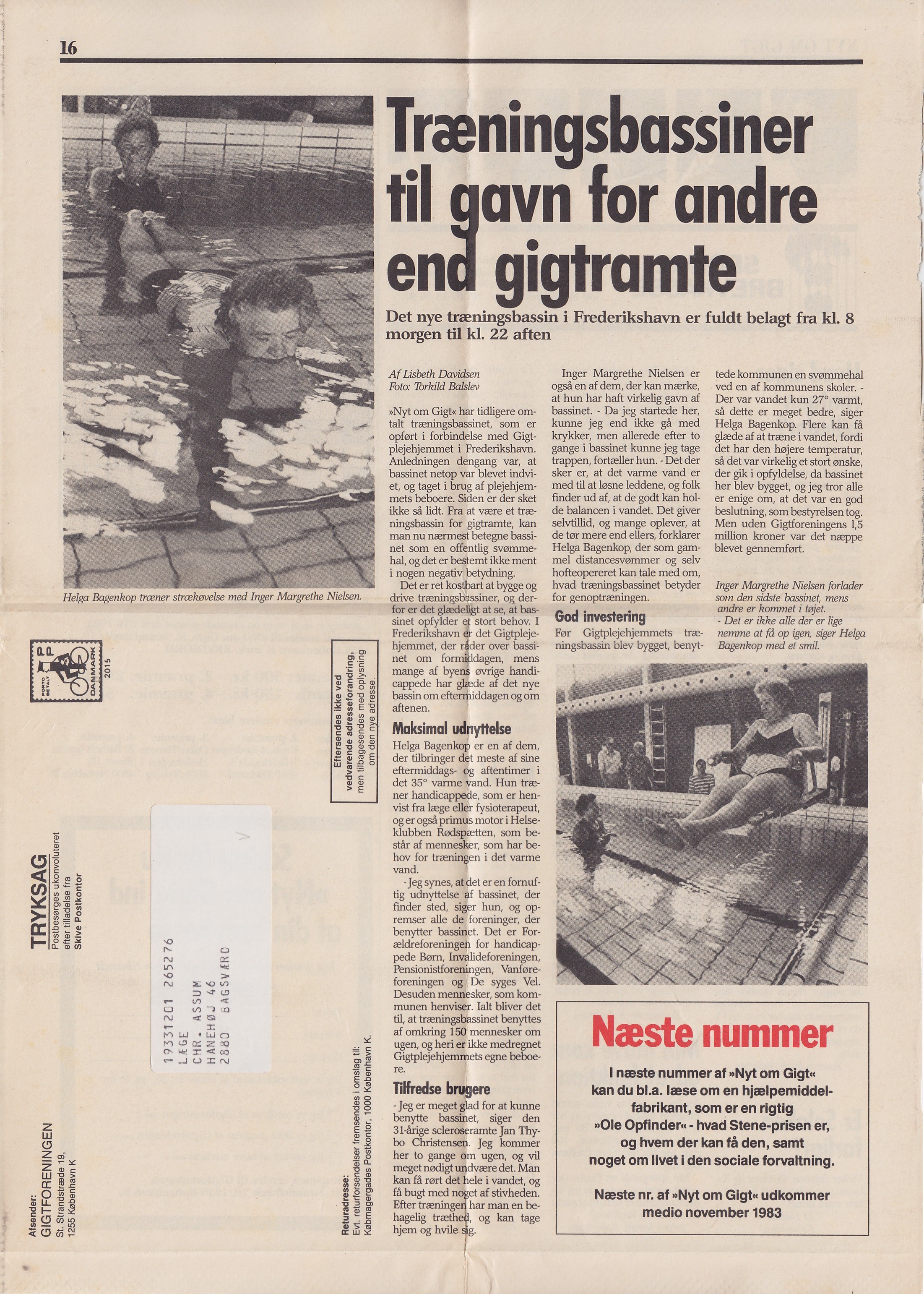
page no. 16 of the magazine "nyt om gigt" from 1983 (news about arthritis / Skive Folkeblad / Postman no. 2015). Congratulations.
Collecting these snippets may not seem very exciting, but from time to time it is rewarded by such finds: 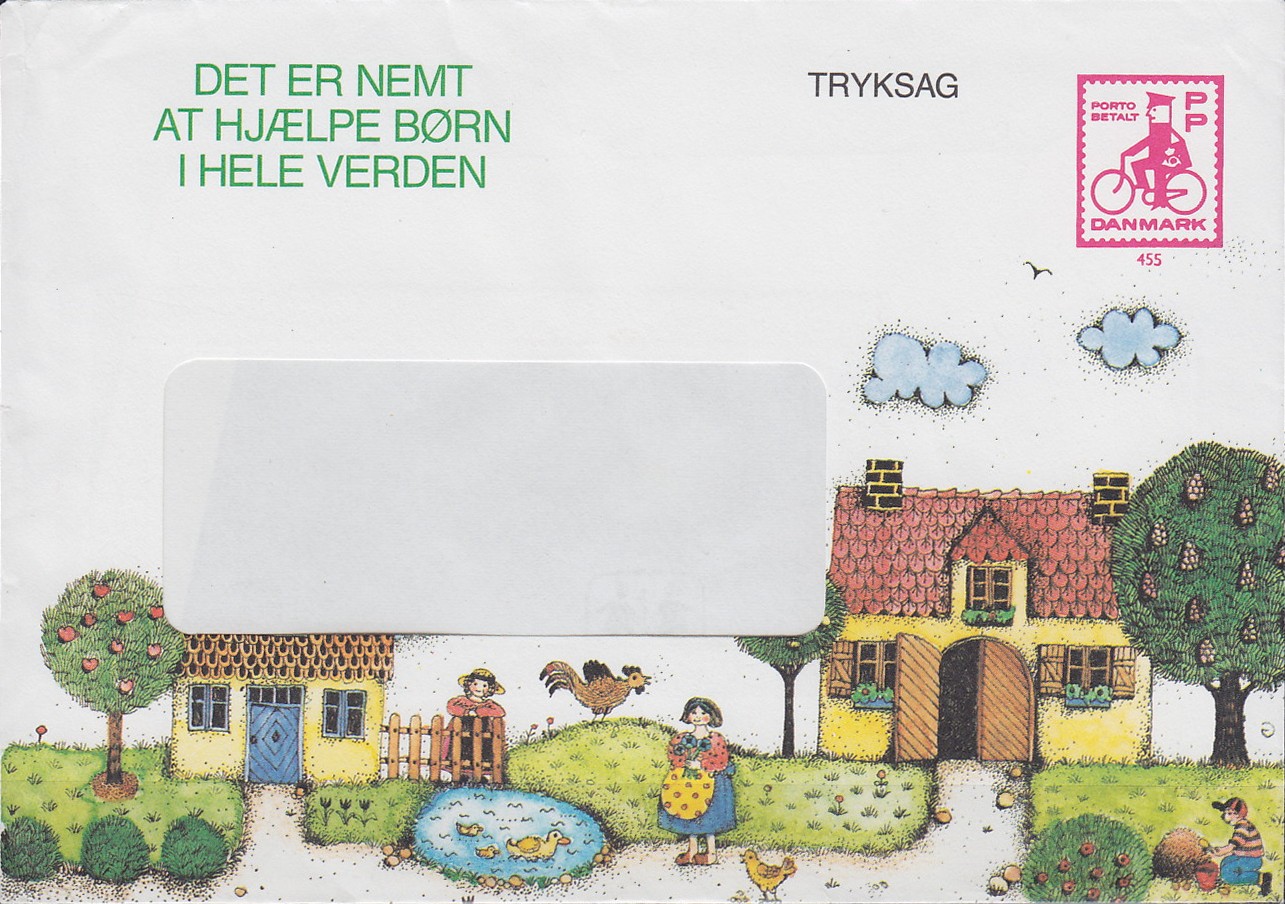
With the large diversity of over 10 000 items a separate bicycle stamp collection can be assembled. The costs are comparatively low. In former times many items ended up in the wastebasket, so that nowadays you have to be patient while searching.
If you don't collect these snippets, you are welcome to offer them for sale: just send an email to:
This email address is being protected from spambots. You need JavaScript enabled to view it..
References:
Forschungsgemeinschaft Nordische Staaten e.V. Special thanks to Detlef Fürth and Rodger Zielinski-Fresberg for the friendly support in providing pictures and extensive information as well as the permission to copy parts of Detlef Fürth's article “Einnahmen sind wichtig - Umsatzsteigerung mittels Ankündigungsschreiben (2)“ – describing the Postens Filateli issues in detail.
Danish Postcancellation Collector Club: Thanks to H. C. Vogensen and K. E. Petersen for your friendly support.
Steve Malone's articles in Bicycle Stamps no. 20A (1996) page 12 and Bicycle Stamps no. 22A (1997) page 18


